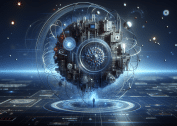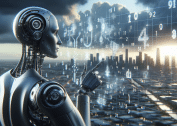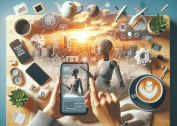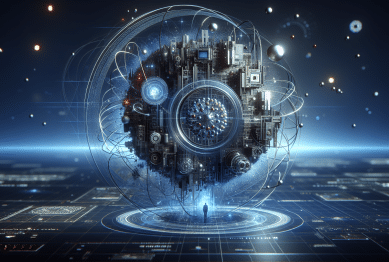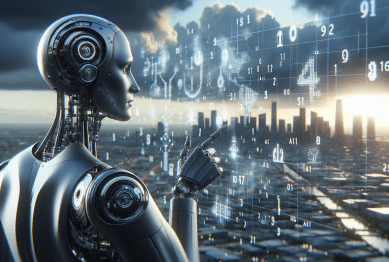Artificial intelligence is transforming daily experiences in subtle but powerful ways. This in-depth guide explores how AI is woven into everything from social media to healthcare, helping you understand the technology’s impact on life, work, and society.
Understanding Artificial Intelligence Foundations
Artificial intelligence, often abbreviated as AI, refers to computer systems engineered to perform tasks that typically require human intelligence. These tasks include learning, problem-solving, pattern recognition, and even language understanding. Many people are surprised to find out that AI solutions are present in a wide variety of devices and online platforms used every day. From voice assistants in smartphones to smart search algorithms, artificial intelligence is quietly revolutionizing basic interactions. High-powered neural networks and advanced machine learning models fuel these improvements, making technology more intuitive, responsive, and accessible for a range of users.
Key advances in artificial intelligence have come from combining big data with rapid computational power. AI algorithms are capable of sifting through massive datasets to identify trends and provide accurate predictions—think of how recommendation engines on streaming services tailor content. These deep learning networks recognize preferences and optimize the experience, personalizing suggestions in real time. Increasingly, industries such as finance and healthcare are leveraging the power of AI to refine risk analysis, detect patterns in medical images, and streamline workflows, helping both organizations and individuals stay efficient.
At its core, AI relies on machine learning, a technology where systems improve automatically through experience. This means that every time someone swipes on a dating app, interacts with social media, or requests directions, machine learning models are refining their responses. Over time, computers become more accurate at tasks such as language translation, image tagging, and voice recognition. This steady progress is setting the stage for even greater adoption of AI across consumer technology and beyond. As a result, the line between digital and human-like interaction is rapidly blurring, offering both convenience and new ethical considerations.
Artificial Intelligence in Everyday Devices
The role of artificial intelligence extends far beyond computer labs and cutting-edge research. Many individuals interact with AI multiple times a day, sometimes without realizing it. Your smartphone’s autocorrect feature, spam filters in your email, and even the curated social media feeds are all driven by sophisticated algorithms. Voice-powered assistants, such as those that answer questions or play music on command, are among the most recognizable forms of AI at home. These systems process spoken commands using speech recognition and natural language processing to deliver fast answers with surprising accuracy.
Other common applications of AI include virtual shopping assistants and smart home devices. Online retailers often deploy AI-powered chatbots to offer recommendations and streamline customer service queries. In the home, programmable thermostats and lighting systems use AI to learn patterns of behavior and optimize settings automatically. High-resolution security cameras rely on AI to detect unusual movement or identify faces, improving safety and response time. This shift toward automation frees up individuals to focus on more important tasks while enhancing comfort, efficiency, and personalization in domestic spaces.
Wearable technology such as fitness trackers and smartwatches has also benefited greatly from AI innovation. These devices collect data on sleep, movement, and heart rate, using algorithms to translate numbers into meaningful advice for healthier living. In some settings, AI-powered software alerts users to irregular activity, providing a proactive approach to wellness. As artificial intelligence capabilities become more deeply embedded in daily routines, expectations for technology that “understands” and adapts increase—transforming how people manage their schedules, health, and even social interactions.
Transforming Work and Industry with AI Solutions
Beyond personal technology, AI has had a far-reaching influence on a diverse range of business sectors. Automation driven by AI has enabled many companies to streamline complex and repetitive tasks, reducing errors and saving time. In manufacturing environments, robotics guided by advanced sensors and AI logic can assemble products with precision and consistency. Digital tools in offices use AI-powered analytics to turn raw data into actionable insights, supporting strategic planning and helping professionals make informed decisions. This ongoing integration continues to reshape the demands of the workforce, opening up new opportunities in tech development but also requiring adaptation as certain roles become automated.
AI-driven technologies are now an integral part of logistics, supply chain management, and customer support. Logistic firms rely on predictive analytics to optimize routes, reduce delivery times, and anticipate demand. Chatbots and virtual agents provide businesses with around-the-clock customer engagement, resolving inquiries with impressive accuracy and speed (Source: https://www.nist.gov/artificial-intelligence). Financial institutions use AI to monitor transactions for signs of fraud or unusual activity, enhancing consumer trust while also meeting regulatory standards. Machine learning models refine credit scoring and risk assessment, supporting more inclusive and efficient lending practices.
Healthcare has seen a surge in AI-based solutions designed to assist clinicians and improve patient care. AI systems analyze medical images to flag potential issues, sometimes spotting details that human eyes might miss. Natural language processing tools help synthesize large quantities of clinical data, making it easier for professionals to review medical histories and recommend personalized treatments. As research continues, AI is poised to play an even larger role in early disease detection, drug discovery, and telemedicine—bridging gaps in accessibility and making cutting-edge care more widely available (Source: https://www.nibib.nih.gov/science-education/science-topics/artificial-intelligence-healthcare).
Artificial Intelligence and Social Media Influence
Social media platforms make significant use of artificial intelligence to drive engagement and curation. Algorithms analyze browsing patterns, friend networks, and user interests to create highly individualized experiences. News feeds, trending topics, and suggested friends or pages often reflect the constant behind-the-scenes computation of massive datasets. AI excels at identifying what content resonates, surfacing posts that attract attention and meaningful interaction. This personalization, while convenient, also raises questions about filter bubbles, privacy, and the potential impact on mental well-being (Source: https://datascience.berkeley.edu/blog/how-ai-is-changing-social-media/).
The proliferation of AI-enabled tools has transformed how stories and advertisements are delivered. Machine learning allows platforms to test headlines, analyze images, and even predict emotional responses to media in real-time. This capability enables marketers and influencers to tailor messages for targeted audiences, maximizing outcomes based on engagement metrics. However, these same techniques have been used to spread misinformation or manipulate user attention, sparking debates about platform responsibility and ethical oversight. Efforts are underway to incorporate transparency, so users have greater visibility into how recommendations are generated.
AI is also being used to support digital safety. Social networks rely on automated systems to flag inappropriate content, combat cyberbullying, and detect fake accounts. These interventions aim to create safer online environments while addressing increasingly sophisticated threats. Nevertheless, the scale and complexity of social networks mean the job is never complete. Continuous upgrades to AI security and moderation systems are essential for keeping up with new challenges. As these improvements roll out, ongoing public discussion will help shape the role of artificial intelligence in fostering more positive digital communities.
AI and the Future of Learning
Artificial intelligence is rapidly transforming the education landscape in innovative ways. Intelligent tutoring systems customize learning plans, assess progress, and adapt content based on individual strengths and weaknesses. These platforms give instant feedback, helping learners stay engaged and motivated. Teachers benefit from AI-driven analytics that highlight areas for more attention, making it easier to provide targeted support. With remote and blended learning models on the rise, AI offers powerful solutions for personalizing the student experience at all levels of education.
Adaptive learning platforms now leverage AI to break big subjects into manageable parts, serving lessons tailored to the knowledge and pace of each user. Speech and image recognition facilitate new ways of interaction, making education accessible to students with different learning needs. Automated grading reduces workloads and introduces objectivity, allowing instructors to focus on mentorship and relationship-building. While these advancements open exciting possibilities, they also highlight the importance of teaching digital literacy and critical thinking alongside technical skills.
Access to quality education remains a global challenge. Here, AI-powered translation and localization tools help bridge language gaps, bringing resources to previously underserved populations (Source: https://ed.stanford.edu/news/ai-education-promise-and-challenges). Researchers are also exploring the potential for conversational AI tutors and virtual labs in science and technology fields. As technology becomes more integrated with everyday learning, the role of artificial intelligence in shaping future opportunities and reducing educational barriers will only deepen.
Ethical Considerations and Responsible AI Use
The rapid advance of AI brings as many ethical concerns as technical excitement. Issues such as data privacy, bias in algorithms, and the transparency of complex models are frequently discussed among experts and the public. Unintended consequences, where AI systems reinforce stereotypes or create unfair outcomes, are being addressed through research and regulation. Many organizations incorporate responsible AI development principles to prevent negative impacts and build trust with stakeholders (Source: https://www.brookings.edu/research/ai-ethics/).
Accountability is central to discussions about trustworthy AI. As automated systems become more influential, calls for explainable AI—where decisions can be easily understood and audited—have grown louder. Designers are turning to techniques that make models more interpretable, and policymakers are establishing frameworks for oversight. International coalitions and non-profit organizations play a key role in defining ethical standards, encouraging inclusivity, and ensuring vulnerable populations benefit from advances. Knowledge sharing between technology developers, academics, and regulators will continue to shape safe AI adoption worldwide.
User awareness is fundamental in the age of AI. Empowering individuals with information about data practices and algorithmic impact fosters more informed choices. Educational initiatives introduce people to the basics of AI and its implications in society, helping them understand benefits and potential risks. As artificial intelligence becomes increasingly embedded in the fabric of daily life, the ongoing challenge is to balance progress with careful reflection to ensure positive outcomes for all (Source: https://cyber.harvard.edu/story/2021-02/ai-ethics).
References
1. National Institute of Standards and Technology. (n.d.). Artificial Intelligence Explained. Retrieved from https://www.nist.gov/artificial-intelligence
2. National Institute of Biomedical Imaging and Bioengineering. (n.d.). Artificial Intelligence in Healthcare. Retrieved from https://www.nibib.nih.gov/science-education/science-topics/artificial-intelligence-healthcare
3. Data Science at Berkeley. (n.d.). How AI is Changing Social Media. Retrieved from https://datascience.berkeley.edu/blog/how-ai-is-changing-social-media/
4. Stanford Graduate School of Education. (n.d.). AI in Education: Promise and Challenges. Retrieved from https://ed.stanford.edu/news/ai-education-promise-and-challenges
5. Brookings Institution. (n.d.). AI Ethics: Principles and Practice. Retrieved from https://www.brookings.edu/research/ai-ethics/
6. Harvard Law School – Berkman Klein Center. (2021). AI Ethics. Retrieved from https://cyber.harvard.edu/story/2021-02/ai-ethics



